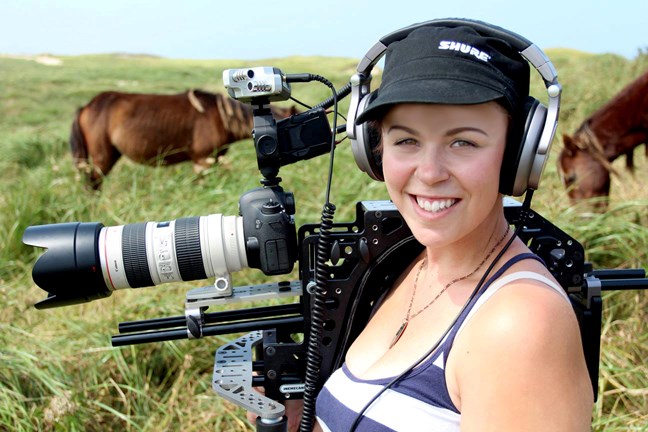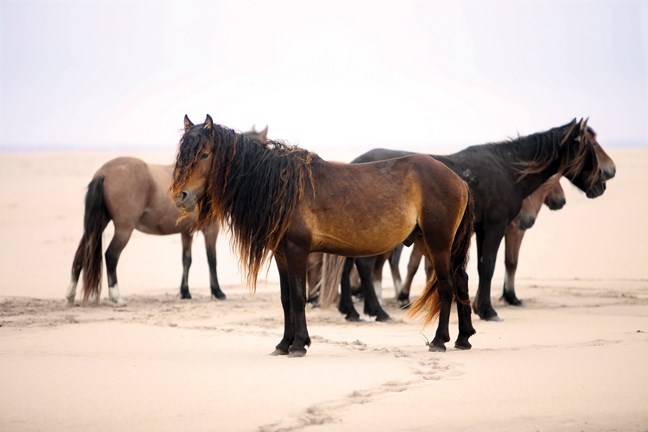As she leaned in to get a closer shot of the water, a big wave crashed into the beach, washing over Rae-Anne LaPlante and her camera.
The Canon 6D she was using to shoot her documentary was soaked and stopped working. It was only the second day of filming.
LaPlante ran back to the little house she was staying in, toweled off the camera, and tried to dry it out with a hairdryer, but the camera wouldn’t turn on. With a tight budget and a backup camera that wasn’t as good, she started calling around for help to no avail.
Finally she took to the Internet. With no other options, she followed a suggestion she found online and put the camera in the freezer overnight.
“I was desperate,” explains LaPlante.
The next day the camera worked.
“It was kind of wonky for a little bit and then it’s been perfect ever since,” she says with a laugh. “Isn’t that crazy?”
Now back at home in Nanaimo, LaPlante recalls some of the ups and downs of her experience filming the documentary S(t)able Island: The Beauty of the Free.
The film follows the history and story of the Sable Island horses, a band of feral horses living wild and free on the small island of the same name off the coast of Nova Scotia.
“I had a lot of good things happen and some negative,” notes LaPlante of the adventure, which started in the fall of 2012.
At that time she was working as a video journalist with Shaw TV when she decided to take a chance and follow a dream.
“I’ve always been crazy about horses and I’ve always had an interest in Sable Island,” she says.
It took some time to work up the courage to launch a Kickstarter campaign, especially after getting some advice from others to not bother wasting her time and money with the project. But when she finally took the plunge, it didn’t take long to raise the money she needed. Fuelling her journey in part was a belief in the importance of contributing to something bigger than herself.

“I think in your lifetime you should do something that lasts longer than yourself,” she notes.
In this case, she hopes to raise awareness about Sable Island and offer an opportunity for people to experience it without actually going there in order to protect the ecosystem.
But filming wild animals was not as easy as she thought. She spent two weeks on the island in August 2013, but for the first two days she didn’t see any horses.
“It felt ridiculous because the island is so small and I didn’t find anything,” she says.
Then on the third day she was travelling up one of the shorelines and came upon a large inlet where she found about 10-15 small herds of horses.
After that, “I kind of went where the day took me,” she says, noting it was difficult to plan a shot list because of the movement of the herds and the varying weather conditions.
Some days it was too foggy to get anything but close-up shots of vegetation, and some days the tern birds were squawking so loudly she couldn’t get any audio.
“I think they were in the middle of their mating season,” says LaPlante, laughing.
She lucked out when she was able to team up with some researchers who allowed her to travel with them on ATVs and showed her the best spots to find the herds.
She also learned a lot about the herd dynamics, including observing young males fighting and challenging each other. One young group in particular basically acted like ”20-year-olds going out partying,” she explains.
A horse owner herself, LaPlante was a bit surprised by the wild version she encountered on the island.
“These horses were very interesting,” she says, noting they seemed more relaxed and calm than her horse is around strangers. “It’s like they don’t have that fear that horses do.”
She attributes it to the fact that they don’t have any predators on the island and haven’t encountered negative contact with humans. The current generation of Sable Island horses is protected by law, and visitors to the island are required to maintain a certain distance from them.
The Sable Island horses also differ in appearance, sporting matted manes, curls and dreadlocks. Without trees to scratch against, the horses scratch themselves on sand dunes so their coats are full of sand.
Also: “They smell not very good.”
Says LaPlante: “I’ve never seen wild horses before so it was interesting to see them in their environment and how they were.”
After she finished filming, it took a year and a half for LaPlante to edit her project at home. During that time she had a baby and started building her family home, and she admits she may have taken on a bit too much at the same time. But the film is now completed and she is entering it in various festivals.
Although the process was challenging, LaPlante is glad she did it and encourages others to follow their passion.
She hopes those who watch her film will see that Sable Island is a fragile place but also a balanced place where everything on it co-exists.
“Even though you have the wild horses that were introduced to the island they’re really part of making the island whole,” she says.
S(t)able Island: The Beauty of the Free is available download, or purchase on Blu-ray or DVD at stableisland.com.
Contact Rosalind Duane at [email protected].



